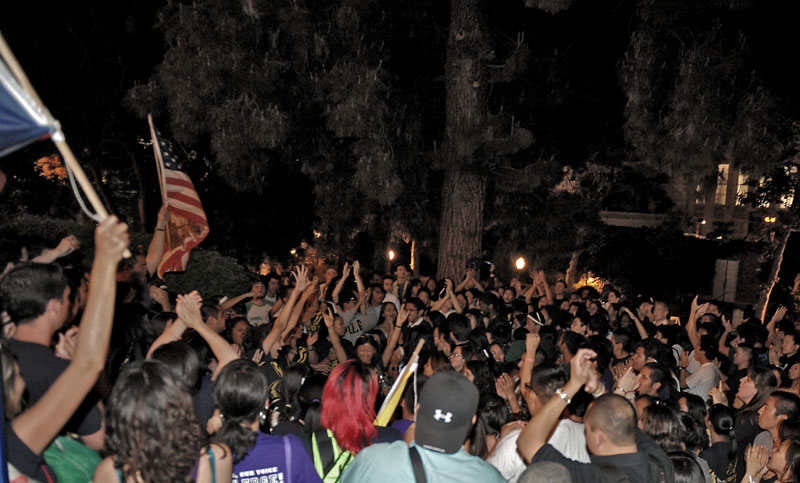It was 1930, and the UCLA campus was a fresh sight in Westwood. There were few buildings and about 6,000 students still adjusting to their new collegiate home.
Kerckhoff Hall was the student hub of the new campus, and student groups used it as a base for their operations. There, they battled each other for office space, fought the administration for more expansive academic and housing options, and tackled larger social issues, such as diversity and greater access to education.
Basically, they were struggling for what students at UCLA struggle for today.
Throughout the university’s history, a student government has led and facilitated these combats. Whether working under the name of Student Legislative Council, which it did until 1982, or the Undergraduate Students Association Council, student leaders have had a huge presence in the progression of student life.
The USAC Structure
Although the name was not changed to USAC until 1982, the student government experienced a huge structural shift in 1965. Prior to that, SLC consisted of elected officers to represent each class (freshmen, sophomores and so on), as well as general upper- and lower-division representatives.
The current commission system that exists now, with general representatives as well as specific commissions, is the result of students’ realization that more student groups could attain the funding they needed for various programs with a voice in the student government, said Farhan Banani, current USAC Community Service commissioner.
One group of students in particular gained support for their community youth program from the Center for Student Programming in the early 1960s, Banani said. They then realized that in order for student groups to have equal representation on campus, a major overhaul of the current system was necessary.
In order to gain support for their proposal to make a commission-based system, the students, led in part by graduate student Tom Hoeber, approached various student groups on campus and proposed different commissions, Banani said.
They garnered support for a campus events commission from fraternities and sororities and a cultural affairs commission from cultural groups, among others, Banani said.
The new system was voted on and approved, and in the 1965-1966 school year, SLC consisted of 12 councilmembers, including four general representatives, four specific commissioners and only one president.
Since 1965, the number of councilmembers has fluctuated between 12 and 19. There are currently 13 students on council.
Councilmembers are currently working on a referendum to overhaul the council system and create a senate system to make way for a larger amount of student representation, Banani said.
But this idea has been proposed and rejected before.
“It’s been looked at, studied and rejected plenty of times,” said Willard Tressel, alumni representative to USAC. “When you get down to it, (the commission system) is a very efficient system.”
Banani said that while the senate system has its merits, it is debatable whether or not it is necessary.
“It’s a very extreme measure to have a radical change in government,” Banani said. “In the ’60s, there was a general sentiment of need for extreme change. Whether that exists today is another question.”
Activism/Access
Although activism in the 1960s resulted in student government changes, SLC was involved in activism on campus prior to this period.
In 1934, for example, the student body president was suspended for bringing a communist speaker to campus because the administration was afraid of “communists coming to radicalize UCLA,” said Steve Halpern, who was the student government president from 1972-1973.
Much of the activism, however, has involved battling discrimination on campus, Halpern said.
Sherrill Luke, the first black SLC president, played a large hand in breaking discriminatory barriers during his tenure from 1959-1960, said Halpern, who is currently writing an extension of William Ackerman’s book, “My Fifty Year Love-In at UCLA.”
“A lot of fraternities and sororities had a lot of discriminatory practices ““ some of it was blatant, some was unspoken,” Halpern said. “One thing (Luke) did as president was to ban discrimination in fraternities and sororities.”
This was an important step in involving black students on campus because there was no on-campus housing for students other than fraternity and sorority houses, and many apartments near campus did not allow black occupants, Halpern said. Thus, many black students had to live far away and commute, and were unable to be as involved in events as other students.
Throughout the years the cause people fight for continues to change, but the issue stays the same, Banani said.
Each decade has seen its own topic of protest, Halpern said.
The ’60s was African American civil rights, the ’70s was anti-Vietnam, the ’80s housed the anti-apartheid movement and the ’90s experienced a Chicano/Chicana studies movement, Halpern said.
“Individual students feel that certain communities don’t have equal access. The community might change, but the issue is still around,” Banani said.
Currently, the internal vice president is responsible for student needs at the university level, and the external vice president organizes lobbying and protests on the local, state and national level, said USAC Internal Vice President Shahida Bawa.
Issues the council deals with today include protecting and speaking for undocumented students, and gaining access to higher education for different socioeconomic groups, Banani said.
For example, USAC appoints students to the chancellor’s enrollment advisory committee to ensure student input in the admissions process, Bawa said.
“This is a very unique student government that does a very good job of getting every group in there,” Banani said.
